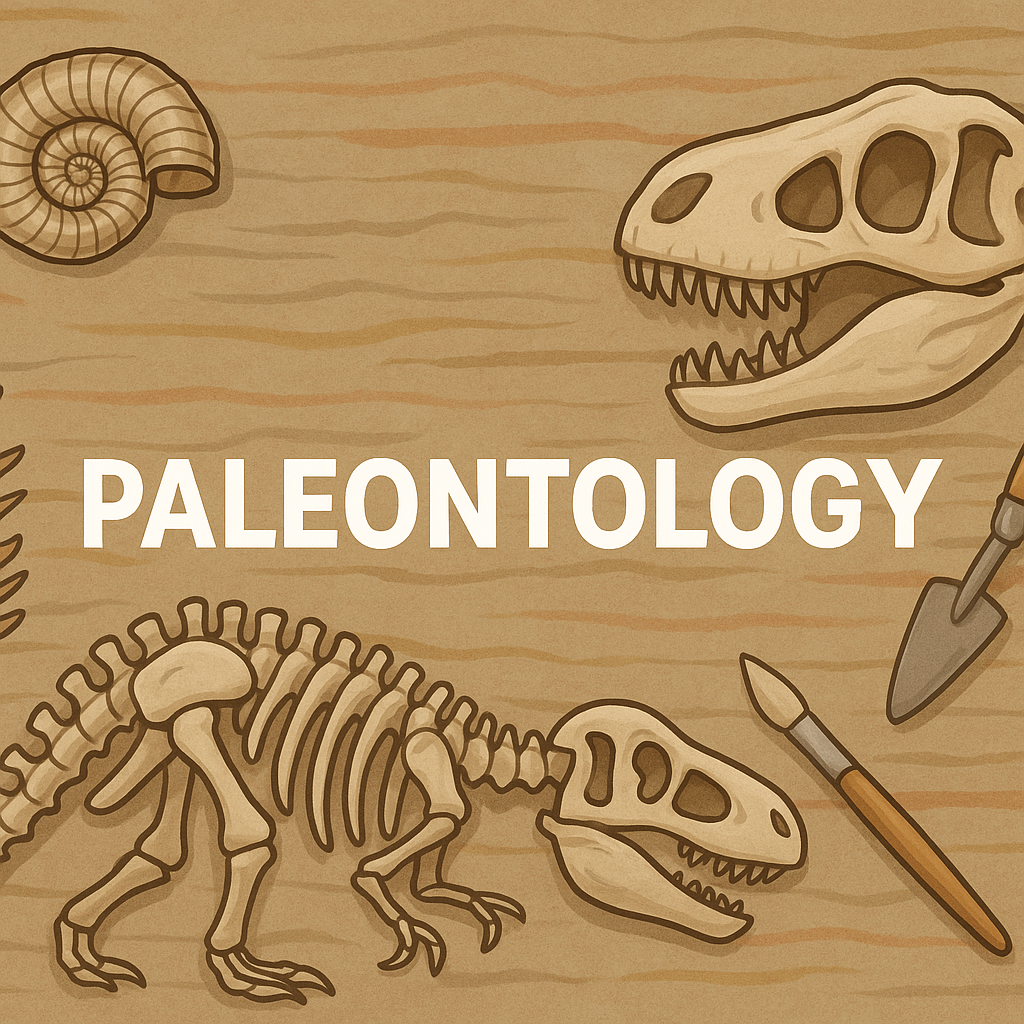1. Which of the following is known as the “Age of Reptiles”?
A) Paleozoic
B) Mesozoic
C) Cenozoic
D) Precambrian
Answer: B) Mesozoic
Explanation: The Mesozoic Era (252–66 million years ago) is often called the Age of Reptiles due to the dominance of dinosaurs and other reptiles.
2. The study of fossilized pollen and spores is called:
A) Palynology
B) Ichnology
C) Paleobotany
D) Taphonomy
Answer: A) Palynology
Explanation: Palynology is the branch of paleontology that deals with microscopic plant remains, especially pollen and spores.
3. The oldest known fossils are found in:
A) Cambrian rocks
B) Ordovician rocks
C) Precambrian rocks
D) Silurian rocks
Answer: C) Precambrian rocks
Explanation: The Precambrian time includes stromatolites and microfossils, some dating back over 3.5 billion years.
4. The principle that in an undisturbed sequence, the oldest layers lie at the bottom is:
A) Faunal succession
B) Cross-cutting relationships
C) Superposition
D) Original horizontality
Answer: C) Superposition
Explanation: The Law of Superposition states that in undeformed sedimentary rock layers, the oldest are at the bottom.
5. Trilobites were dominant during which period?
A) Jurassic
B) Cambrian
C) Devonian
D) Cretaceous
Answer: B) Cambrian
Explanation: Trilobites thrived during the Cambrian Period and are important index fossils of that time.
6. The Burgess Shale is famous for its:
A) Fossilized pollen
B) Preserved dinosaur eggs
C) Soft-bodied fossils
D) Human fossils
Answer: C) Soft-bodied fossils
Explanation: The Burgess Shale (Canada) is renowned for its exceptional preservation of soft-bodied marine organisms.
7. Which of the following is considered a “living fossil”?
A) Coelacanth
B) Tyrannosaurus
C) Archaeopteryx
D) Plesiosaur
Answer: A) Coelacanth
Explanation: Coelacanths were thought extinct until rediscovered in 1938; they closely resemble ancient forms.
8. Which organism is used as a guide fossil for the Ordovician period?
A) Trilobites
B) Graptolites
C) Ammonites
D) Dinosaurs
Answer: B) Graptolites
Explanation: Graptolites are excellent Ordovician index fossils due to their wide distribution and rapid evolution.
9. What does the term “taphonomy” refer to?
A) Study of evolutionary trees
B) Study of fossil formation processes
C) Study of sediment layers
D) Study of dinosaur anatomy
Answer: B) Study of fossil formation processes
Explanation: Taphonomy involves the study of how organisms decay and become fossilized.
10. The fossil of Archaeopteryx is significant because it shows:
A) Mammalian features
B) Evolution of fishes
C) Transition from reptiles to birds
D) Development of amphibians
Answer: C) Transition from reptiles to birds
Explanation: Archaeopteryx had both avian and reptilian traits, making it a key transitional fossil.
11. Which of the following is NOT a body fossil?
A) Tooth
B) Bone
C) Shell
D) Footprint
Answer: D) Footprint
Explanation: Footprints are trace fossils, not body fossils which include actual parts of the organism.
12. What are index fossils used for?
A) Studying mineral formation
B) Dating rock layers
C) Predicting earthquakes
D) Locating groundwater
Answer: B) Dating rock layers
Explanation: Index fossils are species that were widespread but lived for a short geologic time—ideal for correlating rock layers.
13. The evolution of species over geologic time is best studied through:
A) Petrology
B) Seismology
C) Stratigraphy
D) Palaeontology
Answer: D) Palaeontology
Explanation: Palaeontology deals with fossils and evolution across geologic time.
14. Dinosaurs became extinct at the end of:
A) Triassic
B) Jurassic
C) Cretaceous
D) Permian
Answer: C) Cretaceous
Explanation: Dinosaurs became extinct during the Cretaceous-Paleogene (K-Pg) extinction ~66 million years ago.
15. Which mineral commonly replaces organic matter in petrified wood?
A) Calcite
B) Pyrite
C) Quartz (silica)
D) Feldspar
Answer: C) Quartz (silica)
Explanation: Silicification is the common process of petrification, where quartz replaces organic material.
16. Ammonites are useful as index fossils for which era?
A) Paleozoic
B) Mesozoic
C) Cenozoic
D) Precambrian
Answer: B) Mesozoic
Explanation: Ammonites are key marine index fossils from the Mesozoic Era (especially Jurassic and Cretaceous).
17. Which period is known as the “Age of Fishes”?
A) Devonian
B) Carboniferous
C) Silurian
D) Cambrian
Answer: A) Devonian
Explanation: The Devonian period saw major diversification of fish species and is thus called the “Age of Fishes.”
18. Fossil resins, such as amber, are formed from:
A) Animal bones
B) Volcanic glass
C) Plant secretions
D) Marine sediments
Answer: C) Plant secretions
Explanation: Amber is fossilized tree resin and may preserve insects and plant parts.
19. Which era followed the Paleozoic?
A) Mesozoic
B) Precambrian
C) Cenozoic
D) Archaean
Answer: A) Mesozoic
Explanation: The Paleozoic Era ended with the Permian extinction and was succeeded by the Mesozoic.
20. Brachiopods differ from bivalves by:
A) Lacking shells
B) Having symmetrical shells
C) Living in freshwater
D) Having dorsal and ventral valves
Answer: D) Having dorsal and ventral valves
Explanation: Unlike bivalves (left and right symmetry), brachiopods have top (dorsal) and bottom (ventral) shells.

